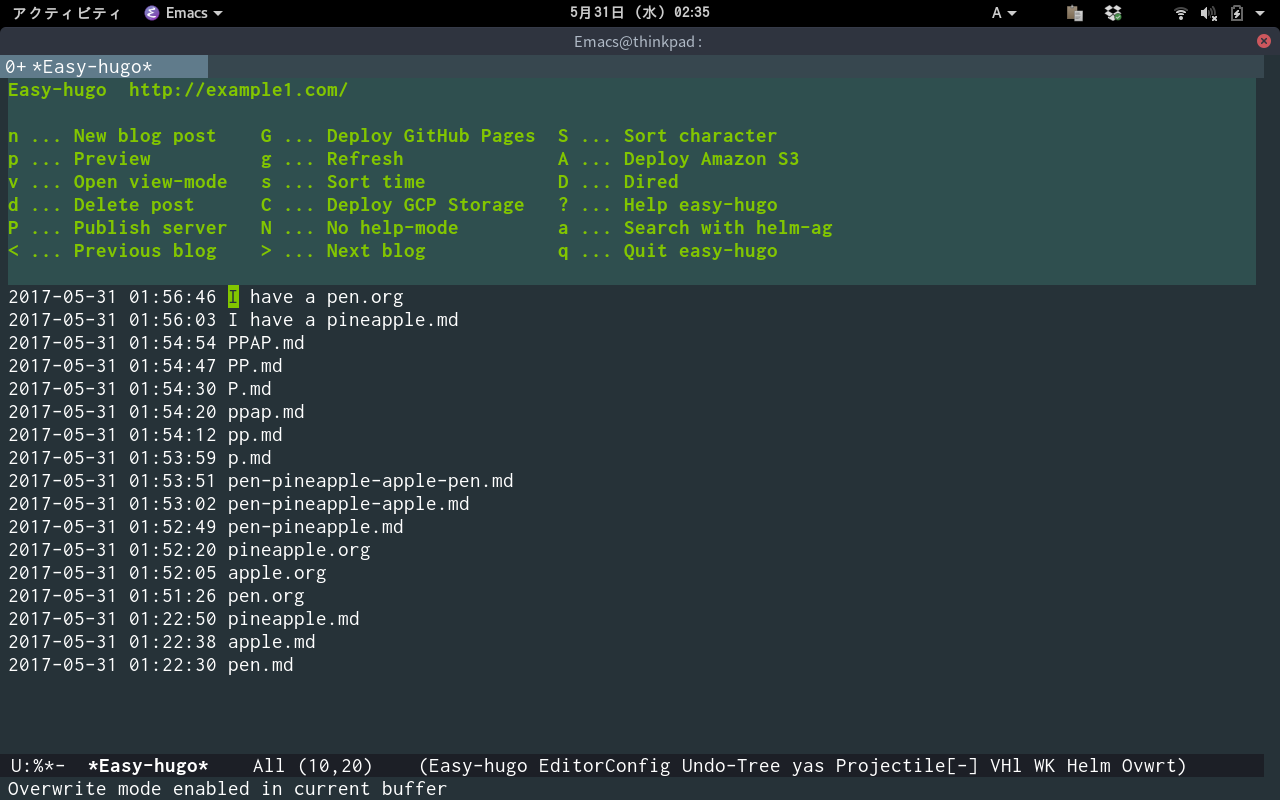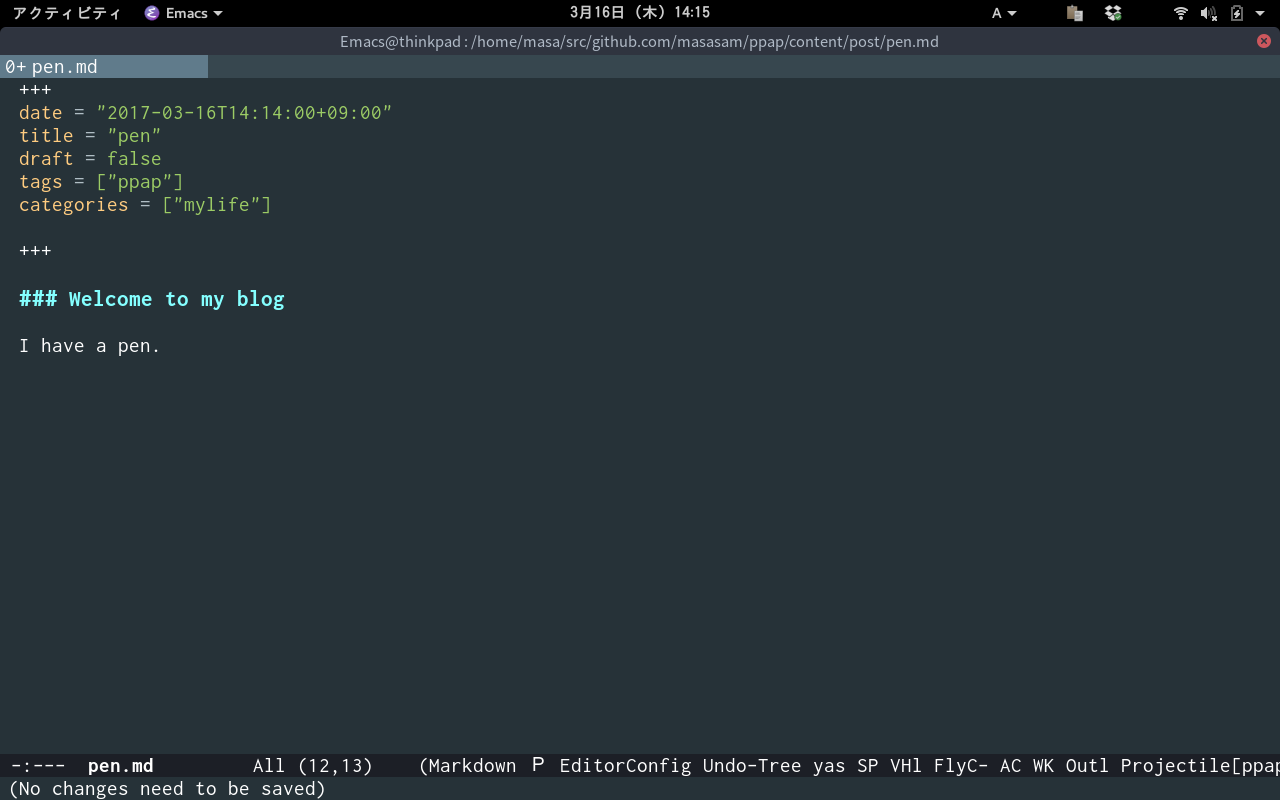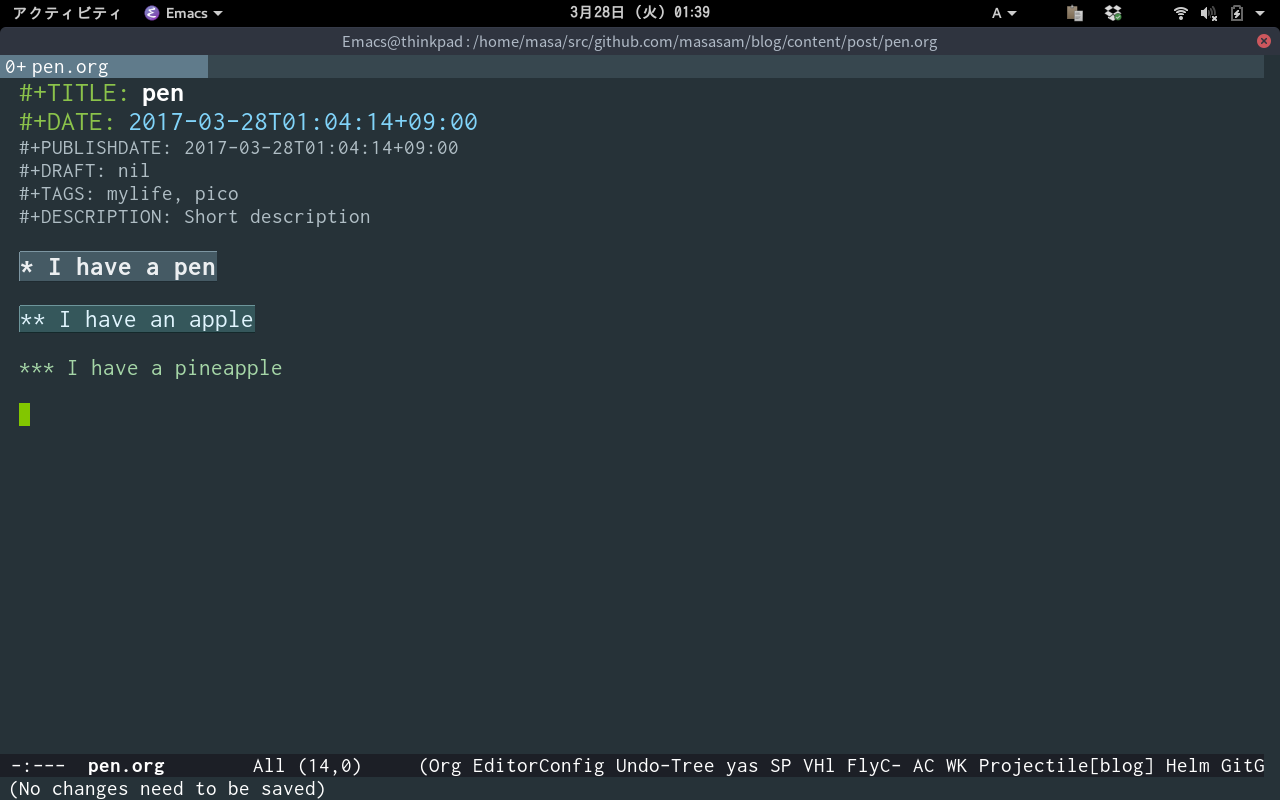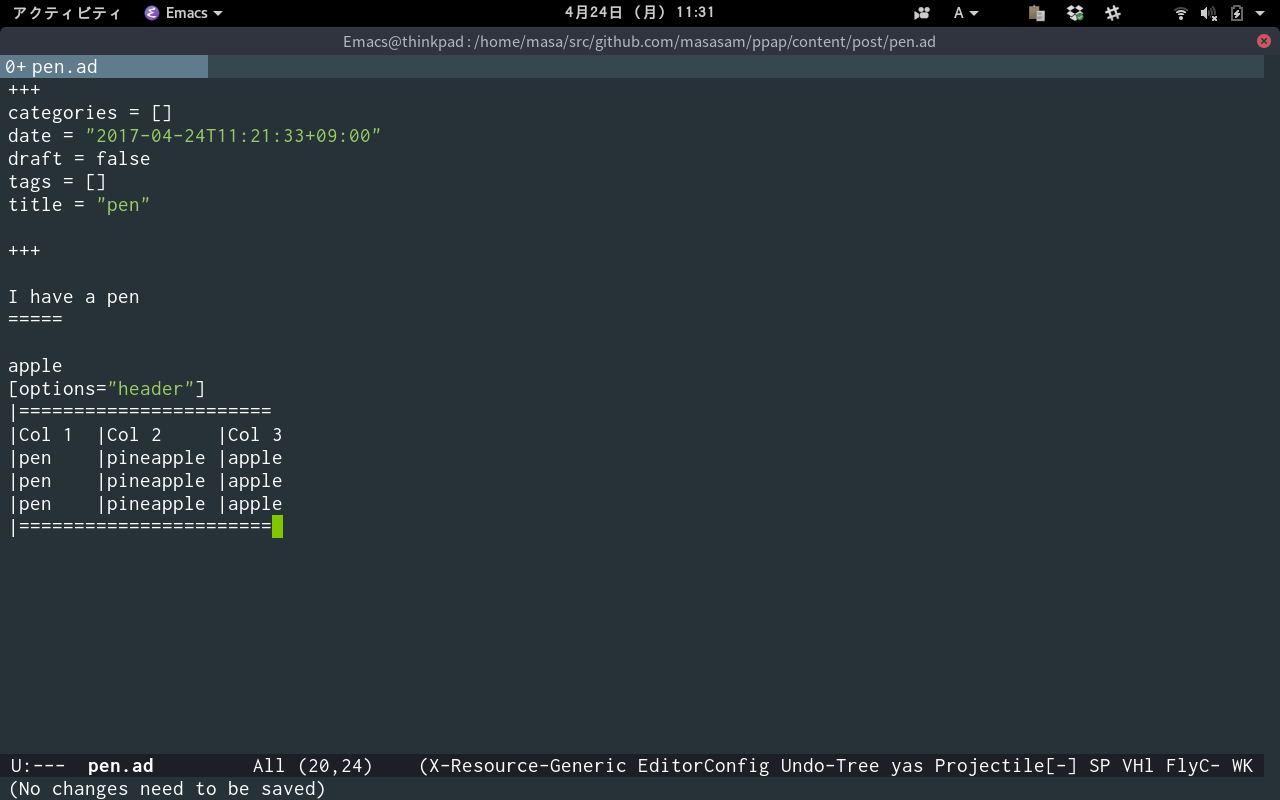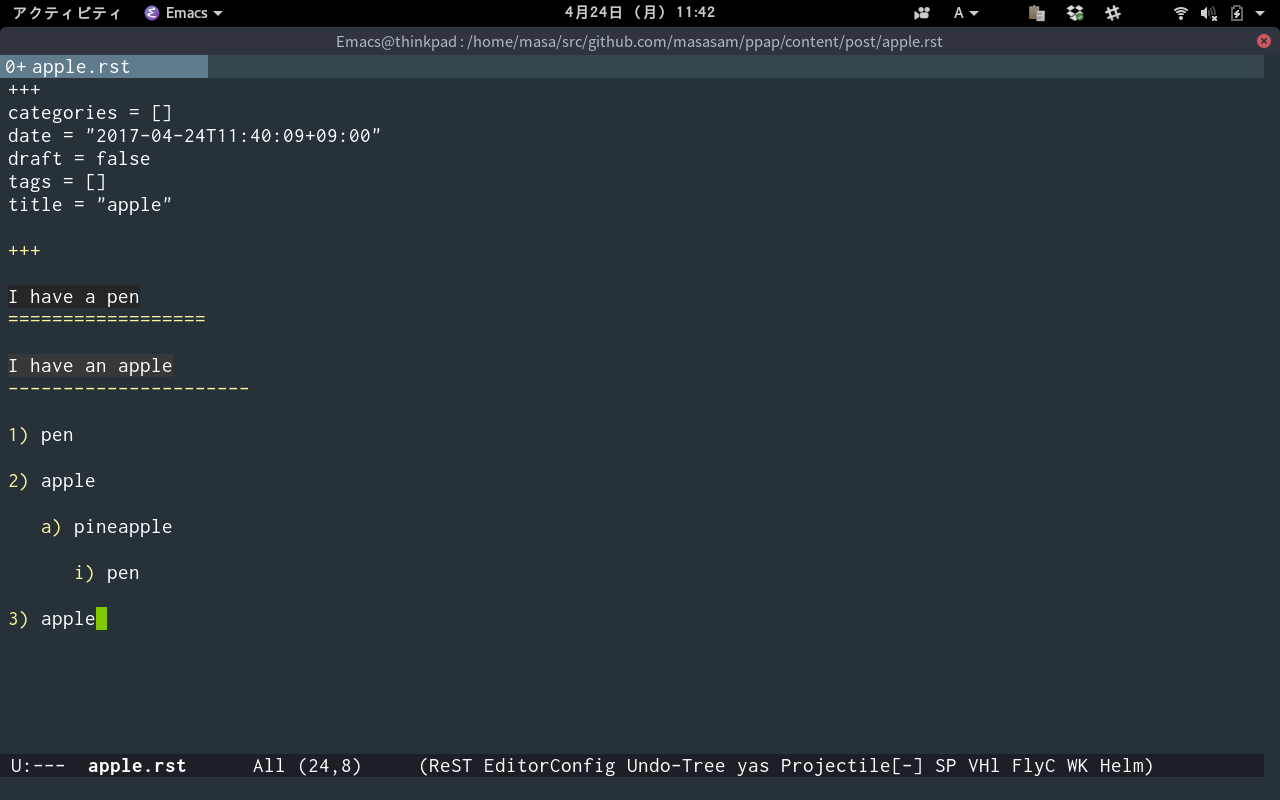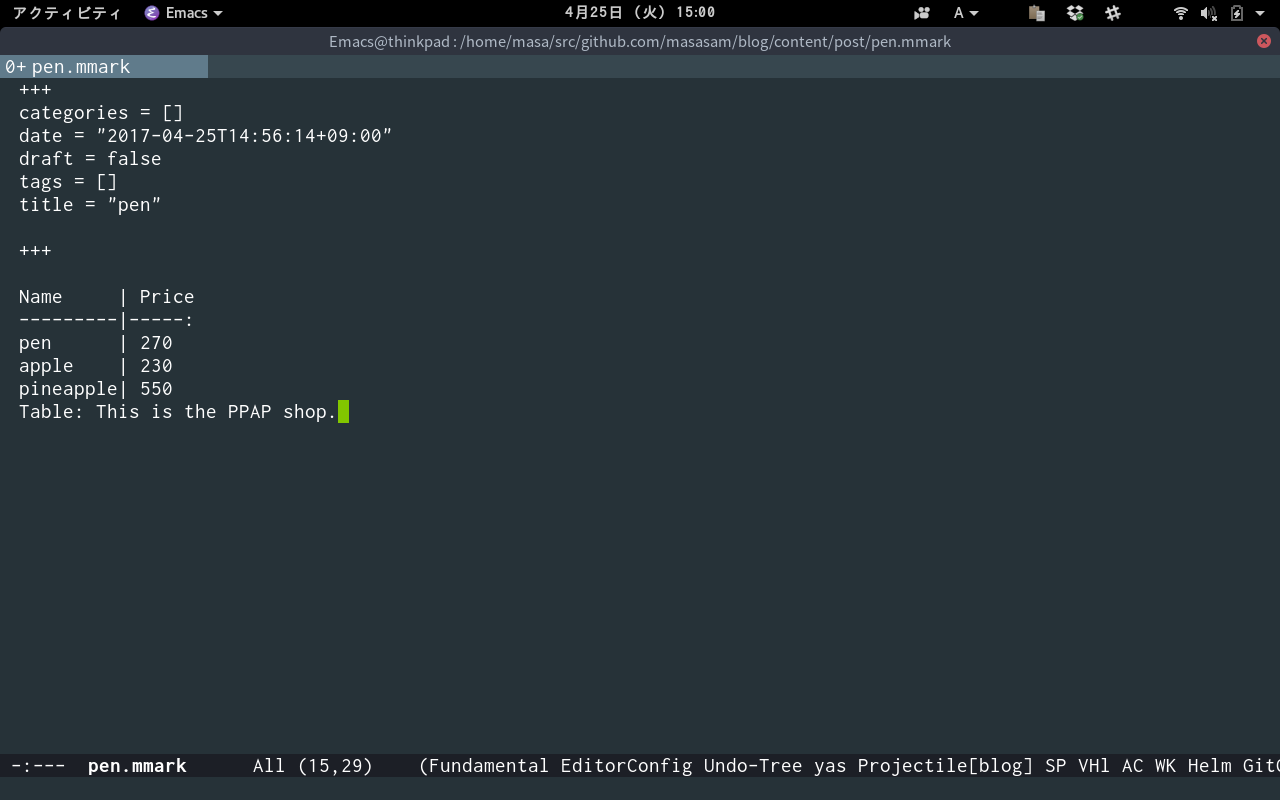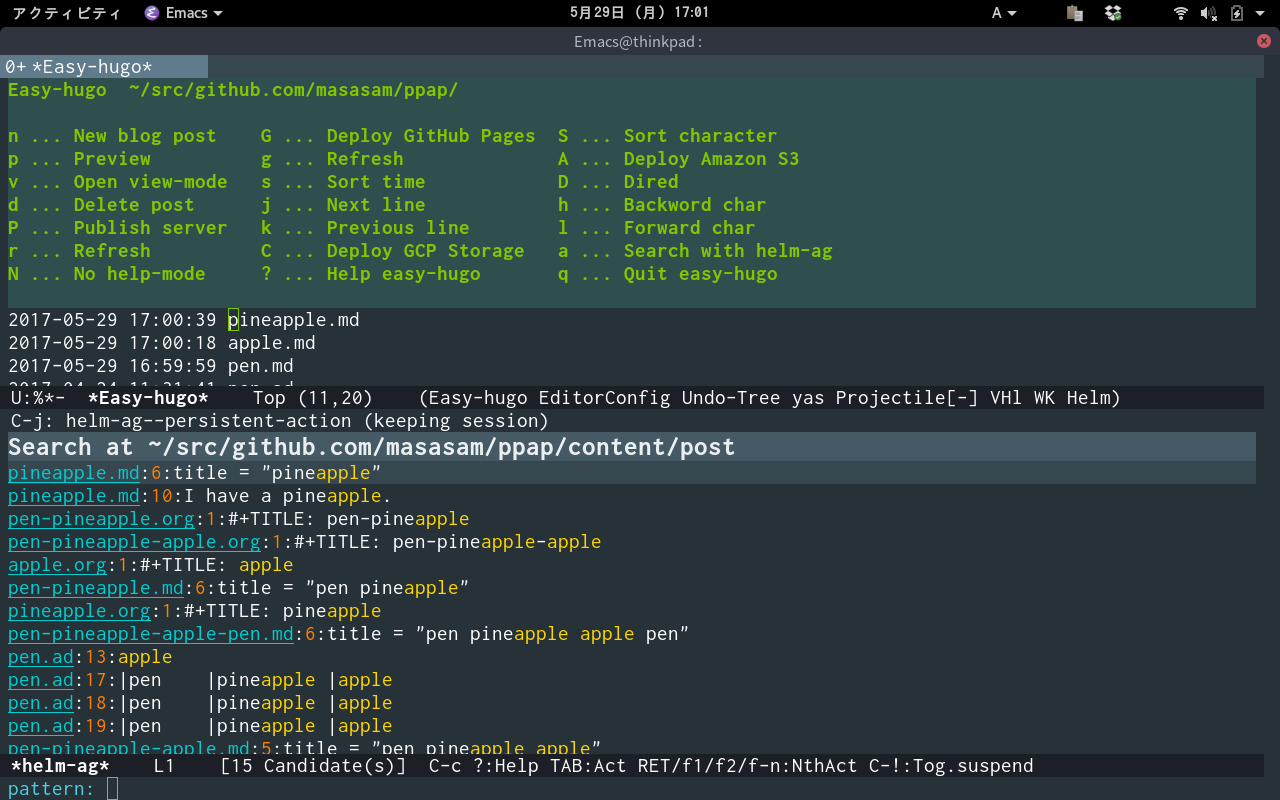Emacs major mode for writing blogs made with hugo by markdown or org-mode or AsciiDoc or reStructuredText or mmark or html
M-x easy-hugo
You can manage blogs on easy-hugo-mode.
If you manage multiple blogs You can switch blogs with the < or > key.
M-x easy-hugo-newpost
You can post a new article.
Enter a article file name in the minibuffer.
A markdown file is automatically generated.
You can write a blog with markdown.
If you enter '.org' file name in the minibuffer, org file is automatically generated and you can write a blog with org-mode.
If you enter '.ad' file name in the minibuffer, AsciiDoc file is automatically generated and you can write a blog with AsciiDoc.
If you enter '.rst' file name in the minibuffer, reStructuredText file is automatically generated and you can write a blog with reStructuredText.
If you enter '.mmark' file name in the minibuffer, mmark file is automatically generated and you can write a blog with mmark.
If you enter '.html' file name in the minibuffer, html file is automatically generated and you can write a blog with html.
M-x easy-hugo-preview
 (The picture of the header is http://www.pixiv.net/member_illust.php?mode=medium&illust_id=60674880)
(The picture of the header is http://www.pixiv.net/member_illust.php?mode=medium&illust_id=60674880)
The browser opens automatically and you can preview the blog on your PC.
Even if you run the easy-hugo-preview command many times, only one hugo process will run so do not mind it.
Since the process of hugo running in the PC disappears in 300 seconds,you do not have to worry about killing hugo process.
M-x easy-hugo-publish
You can publish your blog to the server and the browser opens automatically.
M-x easy-hugo-helm-ag
You can search blog article with helm-ag.
M-x easy-hugo-article
Open the list of articles you wrote with dired.
M-x easy-hugo-github-deploy
Execute deploy.sh which exists in directory 'easy-hugo-basedir'.
It is useful for hosting on GitHub Pages etc.
M-x easy-hugo-amazon-s3-deploy
Deploy hugo source at Amazon S3.
M-x easy-hugo-google-cloud-storage-deploy
Deploy hugo source at Google Cloud Storage.
- Emacs 24.4 or higher
- hugo 0.19 or higher
You can install easy-hugo.el from MELPA with package.el
(M-x package-install easy-hugo).
(setq easy-hugo-basedir "~/bookshelf/")
(setq easy-hugo-url "https://yourblogdomain")
(setq easy-hugo-sshdomain "blogdomain")
(setq easy-hugo-root "/home/blog/")
(setq easy-hugo-previewtime "300")
(define-key global-map (kbd "C-c C-e") 'easy-hugo)
easy-hugo-basedir "Directory where hugo html source code is placed on your PC."
easy-hugo-url "Url of the blog."
easy-hugo-sshdomain "Domain written in ~/.ssh/config."
easy-hugo-root "Root directory of hugo at your server."
easy-hugo-previewtime "Preview display time."
If you want deploy hugo at Amazon S3, please install AWS CLI and set easy-hugo-amazon-s3-bucket-name.
(setq easy-hugo-amazon-s3-bucket-name "your-amazon-s3-bucket-name")
If you want deploy hugo at Google Cloud Storage, please install Google Cloud SDK and set easy-hugo-google-cloud-storage-bucket-name.
(setq easy-hugo-google-cloud-storage-bucket-name "your-google-cloud-storage-bucket-name")
When writing blog with rst-mode at .rst file or web-mode at .html file, "C-c C-e" keys are duplicated so please use other keys.
If you want the default extension to be '.org'.
If not set the default extension will be '.md'.
(setq easy-hugo-default-ext ".org")
If you want the default extension to be '.ad'.
If not set the default extension will be '.md'.
(setq easy-hugo-default-ext ".ad")
If you want the default extension to be '.rst'.
If not set the default extension will be '.md'.
(setq easy-hugo-default-ext ".rst")
If you want to change to No help-mode from startup
(setq easy-hugo-no-help t)
If you want to set charactor-sort at s key. If not set the default s key will be sort time.
(setq easy-hugo-sort-default-char t)
If you want customise color, write the following in the init.el or .emacs.
(defface easy-hugo-help-face
'((((class color) (background light)) (:bold t :foreground "your-hex-color" :background "your-hex-color"))
(((class color) (background dark)) (:bold t :foreground "your-hex-color" :background "your-hex-color")))
""
:group 'easy-hugo-faces)
If you want to manage multiple blogs.
Example of setting when adding two blogs and managing a total of three blogs.
;; Main blog
(setq easy-hugo-basedir "~/bookshelf/")
(setq easy-hugo-url "https://yourblogdomain")
(setq easy-hugo-sshdomain "blogdomain")
(setq easy-hugo-root "/home/blog/")
(setq easy-hugo-previewtime "300")
(define-key global-map (kbd "C-c C-e") 'easy-hugo)
;; Total number of blogs
(setq easy-hugo-blog-number 3)
;; Blog1
(setq easy-hugo-basedir-1 "~/src/github.com/masasam/ppap1/")
(setq easy-hugo-url-1 "http://example1.com/")
(setq easy-hugo-root-1 "/home/blog/")
(setq easy-hugo-sshdomain-1 "blog1domain")
;; Blog2
(setq easy-hugo-basedir-2 "~/src/github.com/masasam/ppap2/")
(setq easy-hugo-url-2 "http://example2.com/")
(setq easy-hugo-amazon-s3-bucket-name-2 "blogbucket")
A total of until 10 blogs can be managed.
Please set necessary variables and use.
easy-hugo-basedir-1
easy-hugo-url-1
easy-hugo-root-1
easy-hugo-sshdomain-1
easy-hugo-amazon-s3-bucket-name-1
easy-hugo-google-cloud-storage-bucket-name-1
..............
easy-hugo-basedir-9
easy-hugo-url-9
easy-hugo-root-9
easy-hugo-sshdomain-9
easy-hugo-amazon-s3-bucket-name-9
easy-hugo-google-cloud-storage-bucket-name-9
If you want change markdown filename extension, please select md or markdown or mdown. Because only these three are supported by hugo. If not set markdown filename extension will be 'md'.
(setq easy-hugo-markdown-extension "markdown")
If you want change asciidoc filename extension, please select ad or asciidoc or adoc. Because only these three are supported by hugo. If not set asciidoc filename extension will be 'ad'.
(setq easy-hugo-asciidoc-extension "asciidoc")
If you want change html filename extension, please select html or htm. Because only these two are supported by hugo. If not set html filename extension will be 'html'.
(setq easy-hugo-asciidoc-extension "htm")
Themes like https://github.com/nishanths/cocoa-hugo-theme store its posts under content/blog. Cocoa-hugo-theme user should add the following settings to init.el or .emacs.
(setq easy-hugo-postdir "content/blog")
Install hugo
Quickstart Guide
See https://gohugo.io/overview/quickstart/
config.toml
hasCJKLanguage = true
theme="material-design"
baseurl = "https://example.com"
languageCode = "ja"
title = "PPAP blog"
MetaDataFormat = "toml"
paginate = 9
copyright = "© 2017 PPAP blog powered by Hugo"
[params]
blogurl = "https://example.com"
blogdomain = "example.com"
github = "your github user name"
twitter = "your twitter user name"
googleAnalyticsUserID = "UA-************"
[permalinks]
post = "/:year/:month/:day/:title/"
Let's build with a free trial of "google compute engine" or "amazon ec2".
If you want deploy hugo at GitHub Pages or Amazon S3 or Google Cloud Storage, This paragraph is not necessary.
I created my blog in google compute engine.
Check if rsync is installed on the server.
Write at ~/.ssh/config on your PC
Host blogdomain
HostName "Your server's IP"
User "Your server's ssh login username"
Because blog is generated under /home/blog/ on the server, set it to reference it with nginx. Ssl uses certbot.
sample nginx.conf
server {
listen 80;
server_name yourdomain;
return 301 https://yourdomain$request_uri;
location / {
root /home/blog;
index index.html index.htm;
}
}
server {
listen 443;
server_name yourdomain;
ssl on;
ssl_certificate /etc/letsencrypt/live/yourdomain/fullchain.pem;
ssl_certificate_key /etc/letsencrypt/live/yourdomain/privkey.pem;
location / {
root /home/blog;
index index.html index.htm;
}
}
Confirm that PATH passes from emacs to go.
For example
(setenv "GOPATH" "~/go")
(add-to-list 'exec-path (expand-file-name "~/go/bin"))
PPAP source sample

